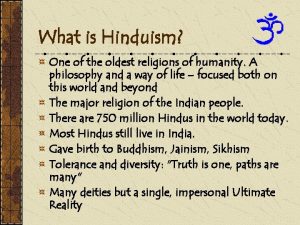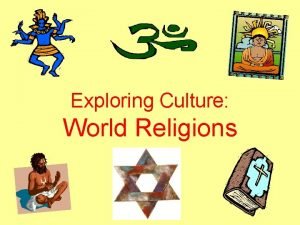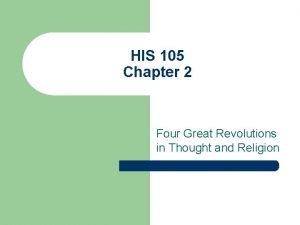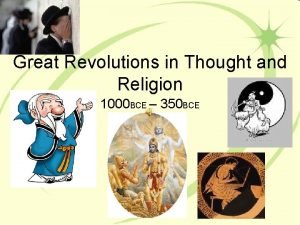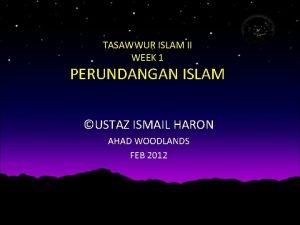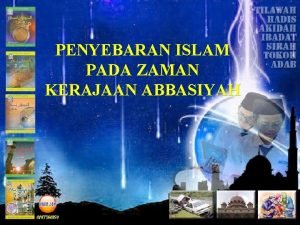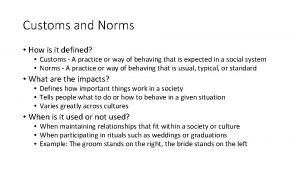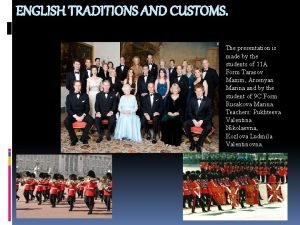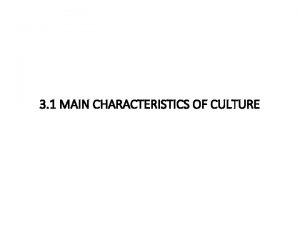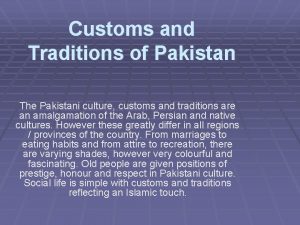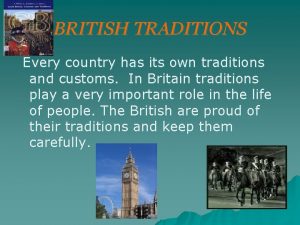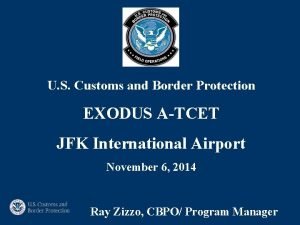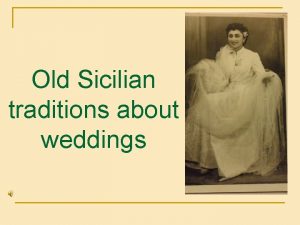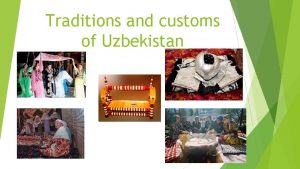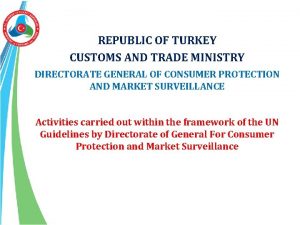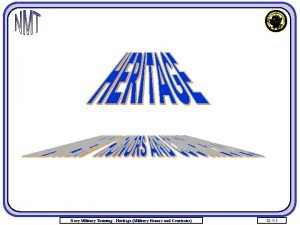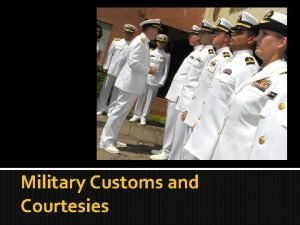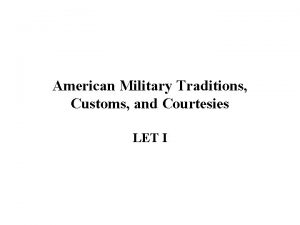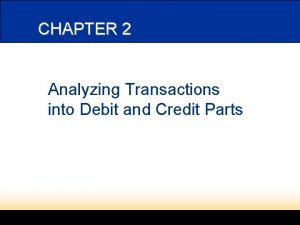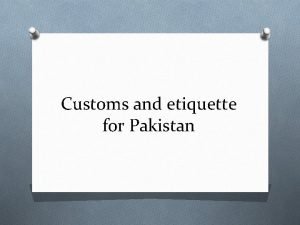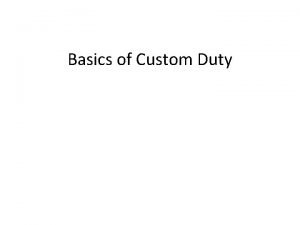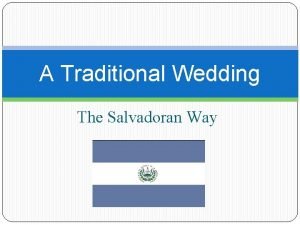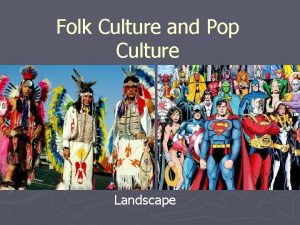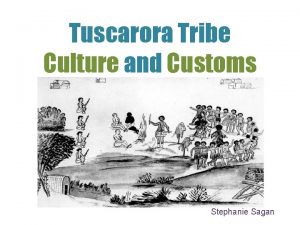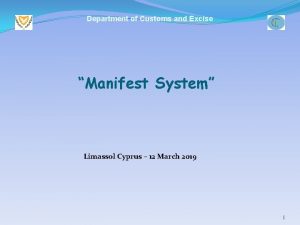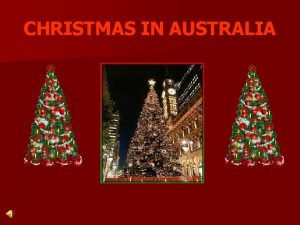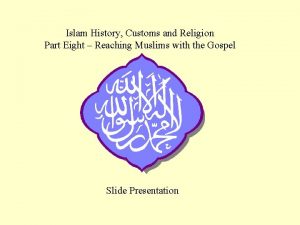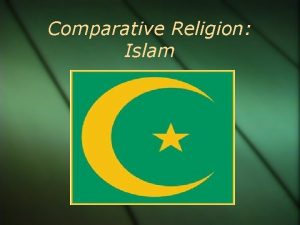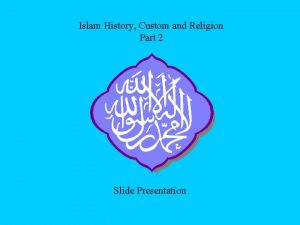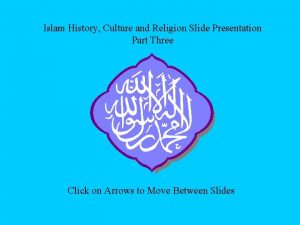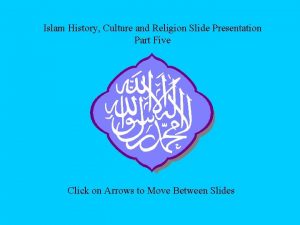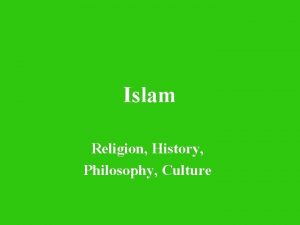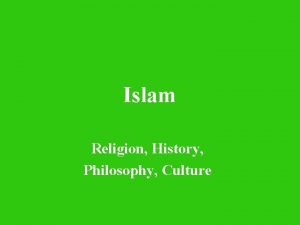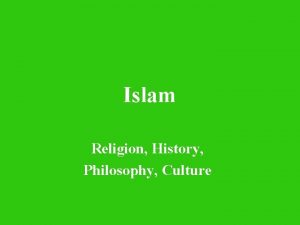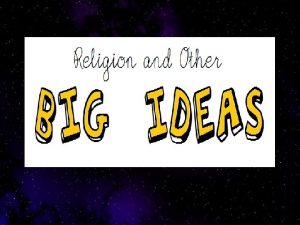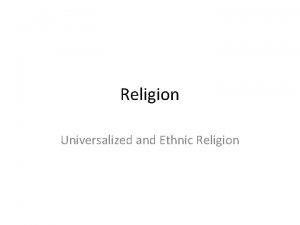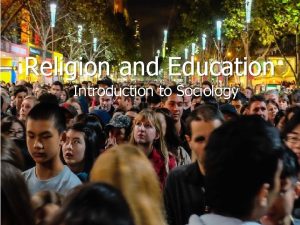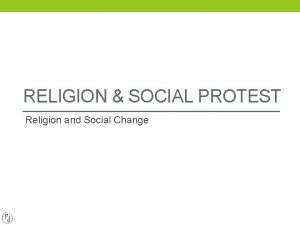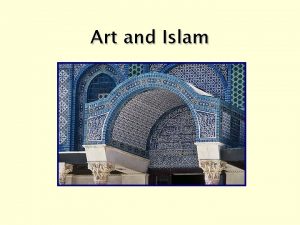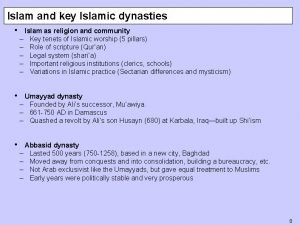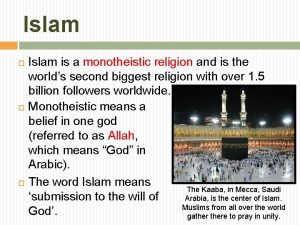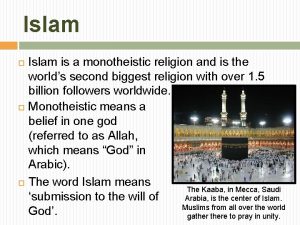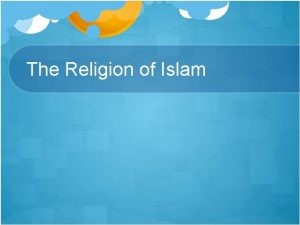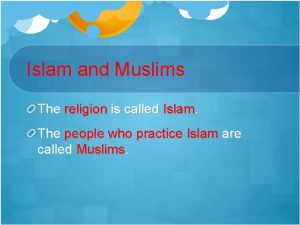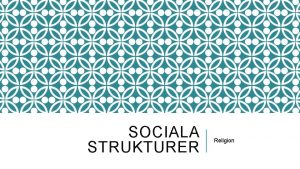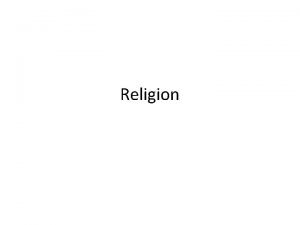Islam History Customs and Religion Part Four Slide



























































![Third, “An Islamic state is bound to [discriminate] between Muslims and non-Muslims. ” (Mawdudi, Third, “An Islamic state is bound to [discriminate] between Muslims and non-Muslims. ” (Mawdudi,](https://slidetodoc.com/presentation_image/a60b96859307043a32f2aef6e0b04dc4/image-60.jpg)















- Slides: 75

Islam History, Customs and Religion Part Four Slide Presentation

Pre-Islamic Arabia And Its Socio-Religious Condition Muhammad Mohar Ali In the article by the above title the author gives a lengthy essay of social and religious conditions in Arabia prior to the establishment of Islam. The full article may be read on the Internet at: http: //bismikaallahuma. org/History/preislamic. htm. Some of the more pertinent points are: “Arab historians and traditions classify the inhabitants of Arabia into two broad divisions, their extinct ancestors and the surviving people. The extinct ancestors are called al- 'Arab al. Ba'idah (the extinct Arabs) who lived and flourished in dim antiquity but who have

gone almost entirely out of existence. Examples of these extinct Arabs are the 'Ad, and the Thamud, the Tasm, the Jadis, the 'Amlaq and others of whom virtually no survivors are found. The Qur'an makes repeated references to those bygone peoples, particularly to the 'Ad and the Thamud. ” “The surviving people are divided into two categories, al- 'Arab al- 'Aribah or the Aboriginal Arabs and al-'Arab al-Musta'ribah or the Naturalized Arabs. The first are the descendants of Ya'rub son of Yashjub, son of Qahtan (Joktan of the Old Testament). They are therefore more generally called Qahtanite Arabs. Their habitat was Yaman. The famous Sabaean and Himyarite kingdoms and their high degree of civilization were the work of these Qahtanite Arabs. The Qur'an makes special mention of the Sabaeans. ”

“The Naturalized Arabs, al-'Arab al-Musta'ribah, were the descendants of Prophet Ibrahim(P) through his eldest son Prophet Isma'il(P). It must not be supposed that they were later in coming to Arabia than the above mentioned Qahtanite tribes from the south. In fact Prophet Isma'il and his mother settled at Makka long before the dispersal of the above mentioned Qahtanite tribes in different parts of Arabia. It should also be noted that Prophet Ibrahim was no non-Arab or non-Semitic person. He descended from the same Semitic Arabs who had long previously migrated and settled in the Tigris-Euphrates valley (Babylonia). In that sense his coming to Makka and settling his son and wife there was a sort of return to the original home of his ancestors. The descendants of Isma'il are called "naturalized Arabs" not really because they were originally non-Semitic outsiders, but mainly because their ancestors had long before left the land. ”

“For a long time indeed the descendents of Isma'il continued to follow the faith and rites in their original forms as introduced by him and his father. With the passage of centuries, however, they gradually deviated from the original faith and succumbed to the natural tendency of the crude and unsophisticated mind to find an easily approachable god for support in times of distress and for redress of wrong, to the tendency to idolize a hero or ancestor, to the sense of helplessness in the face of the forces of nature and, above all, to the influence of the practice of those who were regarded as superior, intellectually, physically or materially. ” Please keep in mind that these quotes are from an Islamic historian and they are presenting his viewpoint.

Introduction of Idols “Polytheism was introduced at Makka after its occupation by Banu Khuza'ah, particularly by their leader 'Amr ibn Luhayy. According to Ibn Hisham 'Amr once went to Syria where he observed the people worshipping idols. He enquired of them of the reasons for their doing so and they replied that they did so because those idols caused the 'rains to fall for them and victory to attend them as they prayed to the idols for these things. 'Amr was impressed and asked them whether they would give him one for his people to worship it. Accordingly they gave him the idol of Hubal which he brought to Makka, placed it near the Ka'ba and asked his people to worship it. As they considered him their leader and wise man they started worshipping the idol. According to Ibn al-Kalbi, 'Amr once fell seriously ill and was told by someone that if he took a bath in a special spring in Syria he would be cured. So he went there, took a bath in that spring and was cured. As he observed the people there worshipping idols he asked them the reason for their doing so, etc. ”

Semite god; a bull with man’s head, one type of idol to be found in early Mesopotamia. Babylonian sun god on a clay tablet. The worship of the sun in many cultures may have prompted Muhammad to look, instead of the sun, to the moon as a god.

Some of the ancient gods were humanized by bodies or heads of animals, birds and men. Many of the gods were real or fictionalized animals. The Ka’ba at the time of Muhammad contained many different types of gods.

“The story illustrates the fact that polytheism found its way among the descendants of Ismail from their neighbours and others. ” “These gods were indeed worshipped by Prophet Nuh's people, as the Qur'an clearly states (Q. 71: 23). They represented certain cults relating to astral worship or worship of the forces of nature or deification of some human qualities, prevalent in ancient Assyria and Babylonia, the land of Nuh's people. ” “Ultimately each and every tribe and clan, in fact every family, had their special idol to worship. On the eve of the Prophet's emergence some 360 idols were placed in and around the Ka'ba. The most important of these was Hubal. It was a big statue in human form of which a hand having been broken the Quraysh had it remade with gold. Two of the idols in the Ka'ba compound were 'Isaf and Na'ila, placed originally on the spot of the Zamzam well but subsequently removed to a spot near the hills of Safa and Marwah. ”

The Pre-Islamic deity "Hubal" was derived from the red skinned Ba-Hubali, another name for Lord Hanuman “Muhammad’s attention then turned to the large statue of Hubal on the roof of the temple. Hubal is none other than Ba-Hubali, another name for Hanuman. The First Encyclopaedia of Islam relates that "Hubal was an idol, made of red carnelian, in the form of a man".

“Anybody who is familiar with Hindu temples knows that Ba. Hubali (Hanuman) is the great Monkey God, the son of the Wind-God. He is always represented in red, and adorns the roof of the temple pinnacle. This is because in the great Hindu epic Ramayana, Ba. Hubali was rewarded for his great devotion to Lord Rama, by being accorded the privilege of always carrying the Hindu flag, which is poised on the pinnacle of temples. Thus the image of Hubal, was none other than the red colored image of Ba. Hubali holding the saffron "Dhvaj" or flag of Hinduism on the roof of the Kaaba temple. “This image of Ba. Hubali was dragged down from the roof, and the saffron flag that it held was trampled into the dirt by the "Holy Prophet". The icon itself was buried in the sand used as a doorstep. This particular practice of the Prophet, of taking down the sacred idol of a temple and using it as a doorstep to trample, on set a precedent that would be extensively followed by the pious adherents of Islam in the future. One has a hard time believing in the "tolerant" nature of Islam, when the Prophet of Islam himself desecrated and insulted another religion in such a disrespectful fashion. ”

“Like a devouring fire, Muhammad's malevolence fed off the innumerable defilements and desecrations that he and the Muslims committed that day. All the other stones that were worshipped in the Temple were used as cornerstones of the Kaaba Mosque structure that was raised. The only idol that Muhammad spared was the black stone known today as "Sangey Aswad", which I have explained before as being the Shivling. The only reason this was spared is that, it was the family deity of Muhammad's clan. In addition, the Prophet was cunning enough to realize that in leaving the Shivling there, he would be guaranteed a sizeable and constant income, by charging pilgrims who would throng to worship the sacred stone. This act by itself invalidates all of Muhammad's pompous claims about idolatry and exposes the selfcontradictory nature of Islam. If indeed his new religion was violently opposed to idolatry in any form, why did the founder of Islam decide to invest a mere Black stone with divinity? In fact, Muhammad is said to have circambulated the Shivling seven times and then to have kissed it, in an exact replication of the manner in which the Vedic Arabs used to pay homage to it. ” Aditi Chaturvedi Vedic Past of Pre-Islamic Arabia - Part 5

The Ka’ba at Mecca “Besides thus making the Ka'ba the principal dormitory of their numerous idols the Arabs had developed a number of subsidiary Ka'bas (tawaghit), so to say, at different places “They used to visit those in the land, each with its shrines at appointed times, presiding god or goddess. ” circumambulate them and make sacrifices of animals there, besides performing other polytheistic rites. ”

“The pre-Islamic Arabs used to worship these idols or gods and goddesses in various ways. They used to make supplication to them, prostrated themselves before them, made offerings to them, beseeched their favour, sought to please or propitiate them in the belief that they were capable of doing good or harm to man, sacrificed animals on altars dedicated to them, made pilgrimages to their shrines, circumambulated them and drew arrows of divination by them or in their shrines. They also used to name themselves after these gods and goddesses…. But though thus engrossed in extensive polytheism and idol-worship the pre-Islamic Arabs did not develop any elaborate mythology or involved theology around their gods and goddesses…. No trace of such things can be found in the pre-Islamic poetry and traditions. This fact further indicates that polytheism and idol worship were not indigenous to the Isma'ilite Arabs but were grafted on to the Abrahamic tradition. ”

“Idols however were not the only abominations, that the Prophet had to destroy in the Kaaba. There were many holy paintings in the Kaaba as well. According to another Muslim historian's account, "Umar began to wash out the pictures with the water of the Zamzam well, when Muhammad placed his hand on a picture of Jesus and Mary and said: "Wash out all except what is below my hands". This is an absolute anomaly. “The Pre-Islamic Arabs were known for their abhorrence towards Christianity and in fact had even fought off the Christian Ruler of Yemen, an Abyssinian by the name Abraha had massacred the Jews of Yemen and sold a third of them as slaves. He had sworn to destroy the Kaaba and in 570 AD, he attacked Mecca for this very reason. However a miracle which the Meccans attributed to their beloved Allah (Durga), is supposed to have turned away Abraha and his hordes. It is ludicrous to imagine that the Meccans would then proceed to put up a painting of the Christian icons, Mother Mary and Jesus, in their sacred precinct of the Kaaba. Muhammad's God himself admits as much in the Quran, where he says the disbelievers show great disrespect for (Jesus). ”

The only painting that was not destroyed in the Kaaba probably depicted Goddess Parvati and the child-god Kartikkeya Source: Amar Chitra Katha “…we can safely conclude that the Painting described by Muslim historians couldn't possibly have depicted Jesus and Mary as claimed. This painting probably depicted the divine motherly representation of Durga(Allah) as Shiva's wife Parvati with the child Kartikkeya was named after the six Kritikkas, which are actually the six stars known as Pleiades. ”

“Since the Kaaba is based on an astronomical plan, it's quite possible that the Kritikkas and the son of God named after them, Kartikkeya would be depicted along with the Mother-goddess in a Temple paintings. The presence of a Shivling in the Kaaba which represents Lord Shiva, the father of Kartikkeya is also significant in this regard. Also one may remember that Muhammad's family were primarily Shiva worshippers and that his name "Muhammad" is derived from the word "Mahadev" which is another name for lord Shiva. Perhaps Muhammad could not dare to demolish this one last reminder of his family's polytheistic past. ” “The initial destruction of all 360 images in the Kaaba, was only the beginning of Muhammad's horrendous rampage. Within a matter of days, he would attempt to destroy as much of Arabia's Vedic heritage as possible. ” The Works "The Life & times of Muhammad" by Sir John Glubb, "An Introduction to the Hadith" by John Burton and "Hindu Temples: What Happened to Them? " by Sita Ram Goel

The Gods of the Quraysh The Quraysh tribe into which Muhammad was born was particularly devoted to Allah, the moon god, and especially to Allah's three daughters who were viewed as intercessors between the people and Allah. The worship of the three goddesses, Al-Lat, Al. Uzza, and Manat, played a significant role in the worship at the Kabah in Mecca. The first two daughters Allah had names which were feminine forms of Allah. The literal Arabic name of Muhammad's father was Abd-Allah. His uncle's name was Obied-Allah. These names reveal the personal devotion that Muhammad's pagan family had to the worship of Allah, the moon god.

Crescent Moon: Symbol of Islam? The crescent moon and star is an internationally-recognized symbol of the faith of Islam. The symbol is featured on the flags of several Muslim countries, and is even part of the official emblem for the International Federation of Red Cross and Red Crescent Societies. The Christians have the cross, the Jews have the star of David, and the Muslims have the crescent moon. What is the history behind the crescent moon symbol? What does it symbolize or mean? How and when did it become associated with the faith of Islam?

The Crescent Moon Symbol The symbol of the worship of the moon god in Arabian culture and elsewhere throughout the Middle East was the crescent moon. Archaeologists have dug up numerous statues and hieroglyphic inscriptions in which a crescent moon was seated on top of the head of the deity to symbolize the worship of the moon god. In the same fashion as the sun is pictured above the Egyptian deity. While the moon was generally worshiped as a female deity in the Ancient Near East, the Arabs viewed it as a male deity.

The Maqam Ibrahim is located in front of the only door of the Ka’ba. Inside the building is a boulder about 2 x 3 feet in size and that claims to have the footprint of Abraham which was imbedded when his foot miraculously sank into the rock when he stood on it. Muslims believe (without proof) that this is the spot where Abraham used to perform prayers near the Ka’ba. They also believe he used it as a stepping stone to build the Ka’ba. Tradition says the Ka’ba was built first by Adam and restored by Abraham and Ishmael, thus the reference to “build the Ka’ba”.

The Crescent Moon Used Today You can see the symbol of the crescent moon on top of the Maqam Ibrahim beside the Ka’ba, as well as nearly every mosque in the world. The historical connection with pagan moon worship is thus obvious.

The Islamic Center In Nashville on 12 th Avenue South. Notice the Crescent Moon and Star on the top of the Center, a symbol appearing on most mosques.

The Black Stone "Before Muhammad appeared, the Kaaba was surrounded by 360 idols, and every Arab house had its god. Arabs also believed in jinn (subtle spirit beings), and some vague divinity with many offspring. Among the major deities of the pre-Islamic era were al-Lat ("the Goddess"), worshiped in the shape of a square stone; al-Uzzah ("the Mighty"), a goddess identified with the morning star and worshiped as a thigh-bone-shaped slab of granite between al Talf and Mecca; Manat, the goddess of destiny, worshiped as a black stone on the road between Mecca and Medina; and the moon god, Hubal, whose worship was connected with the Black Stone of the Kaaba. The stones were said to have fallen from the sun, moon, stars, and planets and to represent cosmic forces. The so-called Black Stone (actually the color of burnt umber) that Muslims revere today is the same one that their forebears had worshiped well before Muhammad and that they believed had come from the moon. (No scientific investigation

The Black Stone has ever been performed on the stone. In 930, the stone was removed and shattered by an Iraqi sect of Qarmatians, but the pieces were later returned. The pieces, sealed in pitch and held in place by silver wire, measure about 10 inches in diameter altogether and several feet high; they are venerated today in patched-together form. )" (Peter Occhigrosso, 1996 The Joy of Sects)

Muslims believe (without proof) that the revered "black stone" (Alhajar Al-Aswad) is a special divine meteorite, that pre-dates creation that fell at the foot of Adam and Eve. It is presently embedded in the southeastern corner of the Ka’ba. Muslims touch and kiss the black stone during Hajj but non-Muslims are strictly forbidden to even touch it. The stone has been attacked many times and is now composed of several pieces and fragments, bound together by a silver ligature. It is semicircular and measures about ten inches horizontally and twelve inches vertically.

“The Arabs' polytheism and worship of idols together with their mistaken notions about Allah determined their whole attitude toward life and society. They considered life in this world to be the be-all and end-all of human existence. They worshipped and propitiated the gods and goddesses and recognized Allah for that purpose alone. They did not believe in resurrection, reward and punishment and life after death. ‘There is nothing but our life in this world; we shall die and live but shall never be raised up again’, so they believed and declared. ” “This attitude led to a sense of ultimate unaccountability and a desire to enjoy the worldly life in all possible ways and without any restrictions. Licentiousness, prostitution, adultery, fornication and unbridled indulgence in wine, women and gambling were thus widely prevalent. Unlimited polygamy was in

vogue and a sort of polyandry, in which a particular woman was used as wife by a number of men (less than 10), was not uncommon. If a child was born in such a case, it was to be accepted by the person whom the woman declared to be its father. Sometimes a person allowed his wife to go to other persons for the sake of having a son. ” “The woman's position in society was indeed unenviable, though she participated in many a social and economic activity and though we sometimes find glowing tributes paid to sweethearts in pre-Islamic poetry. In general, women were treated as chattels. There was no limit to a man's taking as many wives as he liked. Similarly he divorced his wives at will and quite frequently. ”

Arabian Peninsula. The area occupied by the descendants of Abraham and the origin of the religion of Islam.

Arabian Peninsula as seen from space. The lighter area is desert.

“While this was the general socio-religious scene, other religious systems like Christianity, Judaism, Mazdaism (Zoroastrianism) and Sabaism (or Sabianism) had made their way into the peninsula in a limited way. Christianity was introduced in some northern tribes, particularly among the Ghassanid and in Hira mainly at the instance and initiative of the Byzantine authorities. Some princes of Hira had embraced it. In the south it was introduced in Yaman mainly after the first Abyssinian occupation of that land (340 -378 A. C. ). In its neighbouring region of Najran Christianity of the Monophysite type was introduced by a missionary from Syria named Faymiyun. A number of people of the area embraced that faith. There was also a sprinkling of Christian immigrants and converts at Makka at the time of the Prophet's rise. ”

“So far as Judaism was concerned it found its place in the peninsula not so much by conversion as by immigration of the Jews into it. This immigration took place mainly at two periods - one after the Babylonian occupation of Palestine in 587 B. C. and for a second time after the Roman conquest of the land the destruction of Jerusalem by Titus in 70 A. C. A number of Jewish tribes migrated into Arabia and were settled at places like Yathrib (Madina)…Not that they remained completely inactive in the matter of propagation of their faith. According to tradition they made a convert of the Himyarite king (Tubba') Abu Karib As'ad Kamil (385 -420 A. C) when he visited Madina in the course of a northern expedition and sent with him two rabbis to propagate Judaism in Yaman. The extent of the success of these Jewish missionaries in Yaman is not clear; but a descendant of As'ad Kamil's, Dhui Nuwas,

proved to be a vigorous champion of Judaism. He persecuted the Christians not only of Yaman but even massacred the Christian community of Najran, throwing a large number of them in a deep ditch full of fire. His intolerance brought about a joint Byzantine. Abyssinian intervention in Yaman leading to the end of Dhu Nuwas's rule and the beginning of the second Abyssinian occupation of the land under Abrahah. As noted earlier, Abrahah determined to Christianize the whole land, built a gigantic cathedral at San'a' and led a campaign against Makka in 570 -7 1 A. C. to destroy the Ka'ba. ” These were the general conditions which led to the opportunity of Muhammad to establish a new religion which became Islam.

The Development of Islam After the church had been in existence for 500 years, a period in which people were drawn both toward and away from the New Testament pattern, and a period during which the early “church fathers” began organizing into what developed as the Catholic church, a man by the name of Muhammad was born on August 20 in the city of Mecca in 570 A. D. Muhammad was a part of one of the dominant Arab tribes, the Qu’raish (people) and was a part of the trading society of Mecca had become a great trading city and was a stopping place for merchants and businessmen of all races, religions, and countries. It was an open city, open to the world. It was a period of many leaders, none able to control the area for a long period of time.

Muhammad’s father , Abdullah, died before his was born and his mother, Amina, died when he was six years old. His grandfather, Abdul-Muttalib, took him to raise, but he died two years later. An uncle, Abdul-Talib, took him in where he helped run the camel caravan business taking goods to and from Syria and other places.

Muhammad was hired by a widow named Kadijah to help with the caravan she inherited from her deceased husband. At age 25 he married the rich widow (who was 39) whose money allowed him to rise from a lowly position in life. They had three sons (who died in infancy) and four daughters; one Fatima, who became the wife of a great warrior, a Caliph, and eventually a successor to Muhammad. He is believe to have spent a great deal of time in a cave named Hira located on a hill near Mecca (photo). Beginning around 610 A. D. , Muhammad claimed that one night in the month of Ramadan he thought he heard a voice speaking to him twice. Through meditating in the desert cave he claimed God revealed to him through the angel Gabriel certain revelations.

The voice commanded him to read, to which he replied, “I cannot read. ” The voice continued until he asked “What shall I read? ” The response was: “Read in the name of your Lord Who created. He created man from a clot. Read again and your Lord is most Honorable. Who taught (to write) with the pen. Taught man what he knew not. ” (Surah 96: 1 -5) It is claimed that this is the first revelation of the Qur’an brought from heaven by the angel Gabriel. Muhammad never personally wrote down any of these revelations that were received over a period of 23 years. They were written shortly after his death and they are now called the Qur’an. After the experiences in the desert, Muhammad claimed to be a prophet of God with the commission to guide others by God’s message revealed to him. Around 617 A. D. he began to preach to anyone who would listen to him.

His message at first was a simple one: that Allah (God) is one, and is lord of everything. The people of Mecca at this time had a religion called Ka’aba. They literally worship a black stone (a cube). The basis of the religion was the belief that many objects possessed spirits (called jinn) and power, and the black stone was one of these objects. Obviously, the message claiming Allah was Lord was not well received in a society that already had hundreds of gods. The people called Muhammad a sorcerer and a false prophet. They claimed he was possessed, and eventually ran him out of Mecca. His fleeing , or escape, is now called the year of Hijra (Flight, immigration) and marks the first year on the Muslim calendar. Muhammad fled to Medina, a city situated c. 110 mi inland from the Red Sea in a well-watered oasis where fruit, dates, vegetables, and grain are raised. Before the flight from Mecca to the city in 622, Medina was called Yathrib. Muhammad quickly gained control of Medina, successfully defended it against attacks

from Mecca, and used it as the base for converting and conquering Arabia. He used the city as a base for a Holy War (Jihad) against Mecca, which, after eight years he conquered and became its ruler.

The first mosque was built which became a place for the homeless and travelers as well as a place for public discussion and worship. Muhammad used the supposed revelations to govern the community by “divine law. ” This system inaugurated the way of life now known as Islam. A way that controls not only the religious life, but also the political and social life as well. It is the way that Islam continues to advocate today. The early visions of Muhammad suggests he was a prophet to everyone in Arabia, whether pagan, Jewish or Christian, and all of them were to be included in the community life. But when the Jews rejected him as a prophet and his accounts of sacred history he severely denounced them in the Qur’an. In some parts of the Qur’an the Jews are called “people of the book” and were to be tolerated, and in some they are dealt with harshly.

The Black Stone of Islam Upon the defeat of the Meccan army, Muhammad tore down the 360 idols of the Ka’ba and destroyed them, but kept the Black Stone as a sacred part of Islam. The prayers that formally were directed toward Jerusalem must now be said facing Mecca. The Black Stone

Pilgrims to Mecca, after circumambulating the Ka’ba, enter the Ka’ba to see, and if possible, to kiss the Black Stone. “Remember We made the House a place of assembly for men and a place of safety; and take ye the Station of Abraham as a place of prayer; and We covenanted with Abraham and Isma’il, that they should sanctify My House for those who compass it round, or use it as a retreat, or bow, or prostrate themselves (therein in prayer). " (Qur’an 2: 125)

Muhammad established the divine orders he thought he was called to carry out and made a pilgrimage to Mecca a part of his religious reorganization. Islam spread very rapidly during the first 100 years of its existence. With the majority of the Arabian Peninsula under Islam, Muhammad died on June 8, 632 A. D. During his lifetime he did not claim to be an innovator or a revolutionary, only that he was commissioned to complete the work of the Jewish and Christian prophets. In less than 100 years from the advent of Islam, the Islamic Empire extended from Spain to areas of India and China. Islam at that time made no distinction based on race, class, or background, and the Muslim world was considered a worldwide community, the ummah.

“This day have I perfected your religion for you and completed my favor upon you, and have chosen for you Islam as your religion. ” Sura 5: 4. Muhammad rose to become lawgiver, administrator and judge. He brought peace and reconciliation to tribes and families who had long been at war. Abu Bakr said, “If you worshipped Muhammad, he is indeed dead; but if you worship God, He is alive and can never die. ” This statement is the reason why his followers do not wish to be called “Mohammedans”, rather they want to be called “Muslims”.

Some Tenants of Islam Visit to Mecca to worship at the Ka’ba The Ka’ba is a small, cubed building in Mecca towards which Muslims face five times a day, everyday, in prayer. This has been the case since the time of Prophet Muhammad. The current height of the Ka’ba is 39 feet, 6 inches and total size comes to 627 square feet. The walls are all made of stone. The stones inside are unpolished, while the ones outside are polished. This small building has been constructed, it is claimed, by Adam, and reconstructed by, Abraham, Ishmael and Muhammad. Literally, Ka’ba in Arabic means a high place with respect and prestige. The word Ka’ba may also be derivative of a word meaning a cube. It is sometimes associated with the Black Stone which is housed in the Ka’ba.

Worshippers march slowly around the Ka’ba seven times.

The Ka’ba originally held the black stone worshipped as a god along with some 360 other idols housed within the walls. Current belief states that the tribe, the one to which Muhammad belonged, was given the responsibility for the care of the building and abused their power for money which led to the idolatrous use of the building. The square structure is said to represent the unity in Islam. Muhammad adopted the building as a convenient symbol and had the Qur’an to state: “Remember We made the House (Ka’ba) a place of assembly for people and a place of safety; and take ye the Station of Abraham as a place of prayer; and We covenanted with Abraham and Ishmael, that they should sanctify My House for those who compass it round, or use it as a retreat, or bow, or prostrate themselves (therein in prayer). ” –Surah 2: 125


Muslims are supposed to make at least one journey to Mecca during their lifetime in order to worship at the Ka’ba. Worshippers move around the Ka’ba in a circular motion, gradually getting closer to the building as they bow and pray on schedule. The black stone has been adopted as the platform Abraham and Ishmael used to stand on to lay the stone for the base of the building. The Ka’ba and is said to be a symbol of unity. The Five Pillars of Islam Five requirements of all faithful Muslims

1. Faith There is no god worthy of worship except God and Muhammad is His messenger. The declaration of faith is called the Shahada, a simple formula which all the faithful pronounce. In Arabic, the first part is la ilaha illa'Llah- 'there is no god except God'; ilaha(god) can refer to anything which we may be tempted to put in place of God- wealth, power, and the like. Then comes illa'Llah: 'except God', the source of all Creation. The second part of the Shahada is Muhammadun rasulu'Llah: 'Muhammad is the messenger of God. ' A message of guidance has come through a man like ourselves.

2. Prayer Salat is the name for the obligatory prayers which are performed five times a day, and are a direct link between the worshipper and God. There is no hierarchical authority in Islam, and no priests, so the prayers are led by a learned person who knows the Qur’an, chosen by the congregation. These five prayers contain verses from the Qur’an, and are said in Arabic, the language of the Revelation, but personal supplication can be offered in one's own language. Prayers are said at dawn, noon, mid-afternoon, sunset and nightfall, and thus determine the rhythm of the entire day. Although it is preferable to worship together in a mosque, a Muslim may pray almost anywhere, such as in fields, offices, factories and universities.

3. The Zakat One of the most important principles of Islam is that all things belong to God, and that wealth is therefore held by human beings in trust. The word zakat means both 'purification' and 'growth'. Our possessions are purified by setting aside a portion for those in need, and, like the pruning of plants, this cutting back balances and encourages new growth. Each year Muslim calculates his or her own zakat individually. For most purposes this involves payment each year of two and a half percent of one's capital.

4. The Fast Every year in the month of Ramadan, all Muslims fast from first light until sundown, abstaining from food, drink, and sexual relations. Those who are sick, elderly, or on a journey, and women who are pregnant or nursing are permitted to break the fast and make up an equal number of days later in the year. If they are physically unable to do this, they must feed a needy person for every day missed. Children begin to fast (and to observe the prayer) from puberty, although many start earlier. Although the fast is most beneficial to the health it is regarded principally as a method of self-purification. By cutting oneself off from worldly comforts, even for a short time, a fasting person gains true sympathy with those who go hungry as well as growth in one's spiritual life.

5. Pilgrimage (Hajj) The annual pilgrimage to Makkah- the Hajj- is an obligation only for those who are physically and financially able to perform it. Nevertheless, about two million people go to Makkah each year from every corner of the globe providing a unique opportunity for those of different nations to meet one another. Although Makkah is always filled with visitors, the annual Hajj begins in the twelfth month of the Islamic year (which is lunar, not solar, so that Hajj and Ramadan fall sometimes in summer, sometimes in winter). Pilgrims wear special clothes: simple garments which strip away distinctions of class and culture, so that all stand equal before God.

The rites of the Hajj, which are of Abrahamic origin, include circling the Ka'ba seven times, and going seven times between the mountains of Safa and Marwa as did Hagar during her search for water. The pilgrims stand together on the wide plain of Arafat and join in prayers for God's forgiveness, in what is often thought of as a preview of the Last Judgment. In previous centuries Hajj was an arduous undertaking. Today however, Saudi Arabia provides millions of people with water, modern transport, and the most up-to-date health facilities. The close of the Hajj is marked by a festival, the Eid al-Adha, which is celebrated with prayers and the exchange of gifts in Muslim communities everywhere. This, and the Eid al-Fitr, a feast-day commemorating the end of Ramadan, are the main festivals of the Muslim Calendar.

The Zam Sacred well in Mecca, just a few metres to the east of the Ka’ba. The Zamzam is also called the well of Ismail. The well is 35 metres deep, and is marked by an elegant dome. The water is considered health-giving, and pilgrims collect the water in bottles and bring it back home. One of the last things a hajji tries to do, is to dip his or her future burial clothes in the Zamzam.

Muslim tradition states that the Zamzam was opened by the angel Gabriel, to save Hagar and her son Ishmael from dying of thirst, when they were out in the desert. From the sources available, the Zamzam appears to have been revered since long before Muhammad, that is from pre-Islamic times. The Hajj (Pilgrimage) requires eight days of formal ritual including trips (usually by foot) to the site of Hagar and Ishmael’s revival in the desert (her going back and forth looking for water). The stay in Mecca is orchestrated by the Saudi government, the Mecca government and the considerable tourist trade business. Because the Muslim calendar is lunar the month of Ramadan can fall in any part of the year.

The Hajj at a Glance

The Islamic State Islamic states are radically different from a national state. Islamic countries, which are able to impose Islamic law upon their citizens, have an ideological system as their foundation for their political, economical, social and religious life. This system intentionally discriminates between people according to their religious affiliations. A prominent Pakistani Muslim scholar, summarizes three differences between secular and Islamic states as interpreted by the Hanifites: First, “An Islamic state is ideological. People who reside in it are divided into Muslims, who believe in its ideology and non. Muslims who do not believe. ” Second, “Responsibility of policy and administration of such a state ‘should rest primarily with those who believe in the Islamic ideology. ’ Non-Muslims, therefore cannot be asked to undertake or be trusted with the responsibility of policymaking. ”
![Third An Islamic state is bound to discriminate between Muslims and nonMuslims Mawdudi Third, “An Islamic state is bound to [discriminate] between Muslims and non-Muslims. ” (Mawdudi,](https://slidetodoc.com/presentation_image/a60b96859307043a32f2aef6e0b04dc4/image-60.jpg)
Third, “An Islamic state is bound to [discriminate] between Muslims and non-Muslims. ” (Mawdudi, S. Abul `Ala’, The Rights of Non. Muslims in Islamic State, Islamic Publications, LTD. Lahore, Pakistan, 1982). There are four Islamic Schools of jurisprudence. We’ve looked at the view of the Hanifites. The other three schools are the Malikites, the Hanbilities (the most fundamentalists and the strictest), and the Shafi `ites. All four agree dogmatically on the basic creed of Islam but differ in their interpretations of Islamic law that comes from four sources: 1. Qur’an (meaning reading or recite): The sacred book of Muslim community containing direct quotes from Allah as allegedly dictated by the angel Gabriel. 2. The Hadith (meaning narrative): The collections of Islamic traditions including sayings and deeds of Muhammad as head by his contemporaries, first second and third hand.

3. Al-Qiyas (meaning analogy or comparison): The legal decision drawn by Islamic Jurists based on precedent cases. 4. Ijma’ (meaning consensus): The interpretations of Islamic laws handed down by the consensus of reputed Muslim scholars in a certain country. (Samuel Shahid, http: //answering-islam. org/Non. Muslims/right. htm, Internet, Oct. 1, 2001). Differing emphasis upon the various interpretations explains how one Islamic faction can promote the propagation of peace while, at the same time, another Islamic group promotes Jihad, or a Holy War. To harmonize practices, the many splinter groups of Islam usually claim dissenters misquote Qur’anic verses and place them out of context.

Legal Opinions Considered God’s Law The Qur’an has only a few textual laws, the majority of laws are formulated as Fatwa (legal opinion) by prominent scholars in each country and carry equal weight with the Qur’an. Actual laws may vary from country to country depending upon the Fatwa (a term you may have heard in some newscast lately). Some of the more interesting Fatwa are: The two classifications for Non-Muslims (or infidels); (1) Darul-Harb (Household of War), people who are not bound by treaty, or covenant, or whose blood and property as not protected by the law of vendetta or retaliation; (2) Dar-us-Salam (Household of Peace) which is divided into three subgroups: “A. Zimmis (those in custody) are non-Muslim subjects who live in Muslim countries and agree to pay the Jizya (tribute or penalty) in exchange for protection and safety, and to be subject to Islamic law. These enjoy a permanent covenant;

B. People of the Hudna (truce) are those who sign a peace treaty with Muslims after being defeated in war. They agree to reside in their own land, yet to be subject to the legal jurisprudence of Islam like Zimmis, provided they do not wage war against Muslims; C. Musta'min (protected one) are persons who come to an Islamic country as messengers, merchants, visitors, or students wanting to learn about Islam. A Musta'min should not wage war against Muslims and he is not obliged to pay Jizya [tribute or penalty] but he would be urged to embrace Islam. If a Musta'min does not accept Islam, he is allowed to return safely to his own country. Muslims are forbidden to hurt him in any way. When he is back in his own homeland, he is treated as one who belongs to the Household of War. ” (Abdullah, Najih Ibrahim Bin, The Ordinances of the People of the Covenant and the Minorities in a Islamic State, Balagh Magazine, Cairo, Egypt, Volume 944, May 29, 1988; Vol. 945, June 5, 1988).

According to Muslim jurists, the following legal ordinances must be enforced on Zimmis (Christians and Jews alike) who reside among Muslims: 1) Zimmis are not allowed to build new churches, temples, or synagogues. They are allowed to renovate old churches or houses of worship provided they do not add any new construction. "Old churches" are those which existed prior to Islamic conquests and are included in a peace accord by Muslims. Construction of any church, temple, or synagogue in the Arab Peninsula (Saudi Arabia) is prohibited. It is the land of the Prophet and only Islam should prevail there. Yet, Muslims, if they wish, are permitted to demolish all non-Muslim houses of worship in any land they conquer. 2) Zimmis are not allowed to pray or read their sacred books out loud at home or in churches, lest Muslims hear their prayers. 3) Zimmis are not allowed to print their religious books or sell them in public places and markets. They are allowed to publish and sell them among their own people, in their churches and temples.

4) Zimmis are not allowed to install the cross on their houses or churches since it is a symbol of infidelity. 5) Zimmis are not permitted to broadcast or display their ceremonial religious rituals on radio or television or to use the media or to publish any picture of their religious ceremonies in newspaper and magazines. 6) Zimmis are not allowed to congregate in the streets during their religious festivals; rather, each must quietly make his way to his church or temple. 7) Zimmis are not allowed to join the army unless there is indispensable need for them in which case they are not allowed to assume leadership positions but are considered mercenaries.

Special Rules for Islam Women These rules are interpreted and enforced differently in various countries depending upon the degree of political power exercised by the religious leaders of Islam. The following descriptions are typical of the religious practices in the more strict Muslim countries although they may be partially followed in any country where permitted. Three rules for women’s dress code. First, “…we have provided you with garments to cover your bodies, as well as for luxury. But the best garment is the garment of righteousness. ” Surah 7: 26. Second, “They shall not reveal any parts of their bodies, except that which is necessary. They shall not strike their feet when they walk in order to shake and reveal certain details of their bodies. ” Surah 24: 31.

Third, “O prophet, tell your wives, your daughters, and the wives of believers that they shall lengthen their garments. Thus, then will be recognized and avoid being insulted. ” Surah 33: 59. From these verses the Islamic scholars have determined that women should in public ware only long dresses, have a hair covering, and for the extremist, have a veil or face covering. These photos illustrate the “burqa” or lengthened garment with head covering.

The Chador The Hijab

Men are superior to women. "And it is for the women to act as they (the husbands) act by them, in all fairness; but the men are a step above them. " (Surah 2: 228, trans. Rodwell). "Men have authority over women because Allah has made the one superior to the other. " (Surah 4: 34, trans. Dawood). “Men are superior to women because women have less intelligence, are less religious, lack gratitude, and are less reliable as witnesses. It takes two women to equal one man in matters of testimony. ” (Surah 2: 282). Islam is male dominated. Mohammad himself said: ‘the woman is a toy, whoever takes her let him care for her (or do not lose her). " (Tuffaha, Ahmad Zaky, Al-Mar'ah wal- Islam, Dar al-Kitab al. Lubnani, Beirut, first edition, 1985, p. 180). The belief that a woman is a toy is of vital importance for the spiritual well being of a Muslim man. "In the company of women, looking at them, and playing with them, the soul is refreshed, the heart is rested, and the man is strengthened to the worship of God. . . this is why God said:

'That he might rest in her. ' (Surah 7: 189)" (Ihy'a 'Uloum ed-Din by Ghazali, Dar al-Kotob al-'Elmeyah, Beirut, Vol II, Kitab Adab al. Nikah, p. 34). The husband’s desires are to met at once. Obedience to a husband is the key to paradise for a wife (Surah 4: 34) and he may beat her for any disobedience (some translations say “beat lightly”). A husband’s rights are considered divine. He is her Paradise or Hell. If Allah were not the only one to be worshipped, then the wife would be required to worship her husband. (Mishkat al -Masabih, English translation, Section 'Duties of husband wife', Hadith No. 70).

Women in Islam The state of women in Islam is described variously, depending upon which side one takes. "The most satisfying and final word on the matter is that marriage is a form of slavery (riq). The woman is man's slave and her duty therefore is absolute obedience to the husband in all that he asks of her person. As Mohammad himself said: 'A woman, who at the moment of death enjoys the full approval of her husband, will find her place in Paradise'. ” http: //debate. domini. org/newton/womeng. html

The Veil and Islam There is a debate within Islam over the use of the veil. Some countries require it and others do not. Three attitudes are emerging: Very relaxed dress code, moderate dress code, and very strict dress code.

Women try to be active participants in modern Islamic society and some have moved away from traditional dress to adopt new forms (window in Egyptian store) which are both modest and stylish.

Islam has many other ideologies that are strange to western cultures but accepted as the norm in Islam dominated countries. All of these ideologies, which are both religious and political, create problems when foreigners travel in Muslim lands. They interfere with business and trade, and make it most difficult to take the gospel to these lands. Knowledge of these beliefs and practices will at least put one on his guard considering the current events in the shrinking world in which we live.

End of Part Four Slide Presentation Click On Right Arrow to End or Move to Slide 1 To Start Over
 Insw pib
Insw pib What are the basic dance steps in heel and toe polka
What are the basic dance steps in heel and toe polka Western religion vs eastern religion
Western religion vs eastern religion Oldest religion in the world
Oldest religion in the world Religion islam
Religion islam Religion islam
Religion islam Four great revolutions in thought and religion
Four great revolutions in thought and religion Aryan food
Aryan food Faedah mengamalkan perundangan islam
Faedah mengamalkan perundangan islam Cara mencapai matlamat perundangan islam
Cara mencapai matlamat perundangan islam Latar belakang kerajaan bani abbasiyah
Latar belakang kerajaan bani abbasiyah Shapes with straight sides
Shapes with straight sides Glencoe accounting chapter 14
Glencoe accounting chapter 14 How to factor a binomial
How to factor a binomial Unit 4: our customs and traditions
Unit 4: our customs and traditions Every nation has its own
Every nation has its own Custom norms
Custom norms British traditions and customs presentation
British traditions and customs presentation Ecommerce-portal of central board of excise and customs
Ecommerce-portal of central board of excise and customs Site:slidetodoc.com
Site:slidetodoc.com Things fall apart customs
Things fall apart customs The uniform customs and practice for documentary credits
The uniform customs and practice for documentary credits Customs and traditions in russia
Customs and traditions in russia Navy customs and traditions
Navy customs and traditions Pakistan customs and traditions
Pakistan customs and traditions Refers to the knowledge language values customs
Refers to the knowledge language values customs Every country has its own traditions and customs
Every country has its own traditions and customs Customs and border protection
Customs and border protection Customs and border protection
Customs and border protection Sicilian traditions and customs
Sicilian traditions and customs Uzbek navruz bayrami
Uzbek navruz bayrami Ministry of customs and trade turkey
Ministry of customs and trade turkey Navy customs and courtesies
Navy customs and courtesies Military customs and courtesies
Military customs and courtesies Egyptian god weapons
Egyptian god weapons Easter in britain
Easter in britain Military traditions and customs
Military traditions and customs Portugal april fools day
Portugal april fools day 4 eyes assessment
4 eyes assessment Four part processing model for word recognition
Four part processing model for word recognition Four part processing model for word recognition
Four part processing model for word recognition Introduction to csr
Introduction to csr Part two—analyzing the effect of transactions
Part two—analyzing the effect of transactions Addition symbol
Addition symbol Part to part ratio definition
Part to part ratio definition Part part whole
Part part whole Technical description
Technical description The centerpiece of any pouring station.
The centerpiece of any pouring station. The part of a shadow surrounding the darkest part
The part of a shadow surrounding the darkest part Two way anova minitab 17
Two way anova minitab 17 Tiep
Tiep Section 32 customs act
Section 32 customs act Cmo 27-2009
Cmo 27-2009 Customs pga
Customs pga Pakistan greeting customs
Pakistan greeting customs Customs assessment
Customs assessment Basic custom duty
Basic custom duty Websitepromotionaltools.com
Websitepromotionaltools.com Traditional el salvador wedding
Traditional el salvador wedding Https //www.usps.com/intl/customs.htm
Https //www.usps.com/intl/customs.htm What is the tea
What is the tea Huttula customs
Huttula customs Customs broker triennial status report 2021 form
Customs broker triennial status report 2021 form Borders divide customs connect
Borders divide customs connect Folk cultural landscape
Folk cultural landscape Customs of england
Customs of england Tuscarora tribe traditions
Tuscarora tribe traditions Theseas customs
Theseas customs Christmas customs in australia
Christmas customs in australia Mayan customs
Mayan customs Sars customs worksheet
Sars customs worksheet Technical committee on customs valuation
Technical committee on customs valuation World on a turtle's back story
World on a turtle's back story Seapil
Seapil Ecuador customs
Ecuador customs Ecuador customs
Ecuador customs



